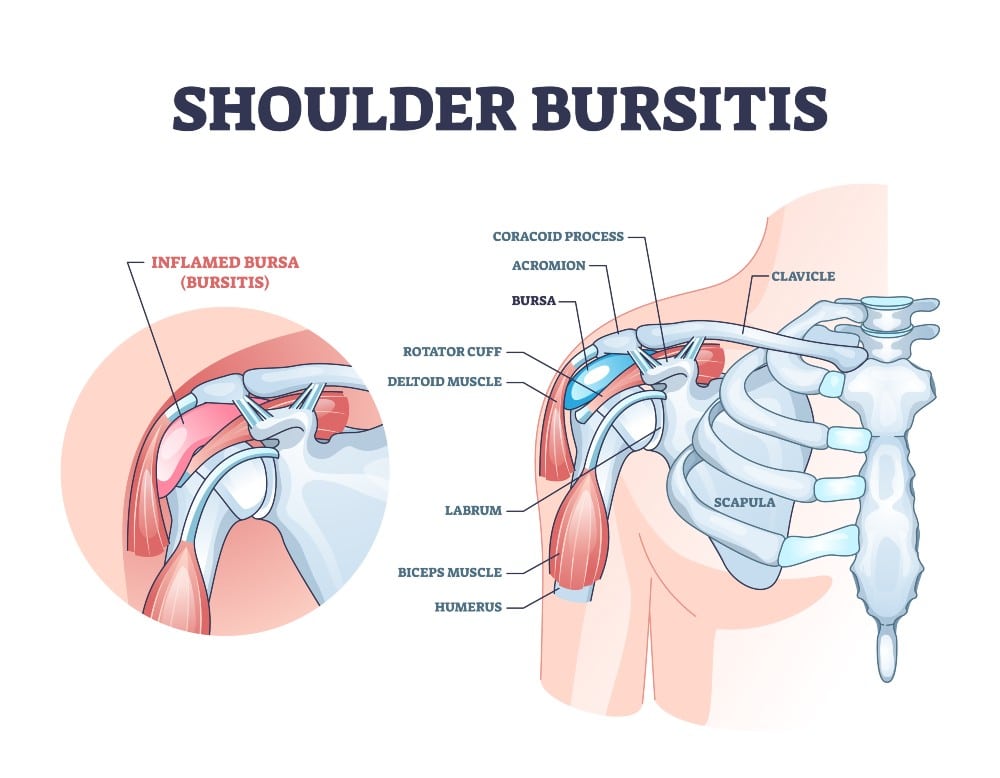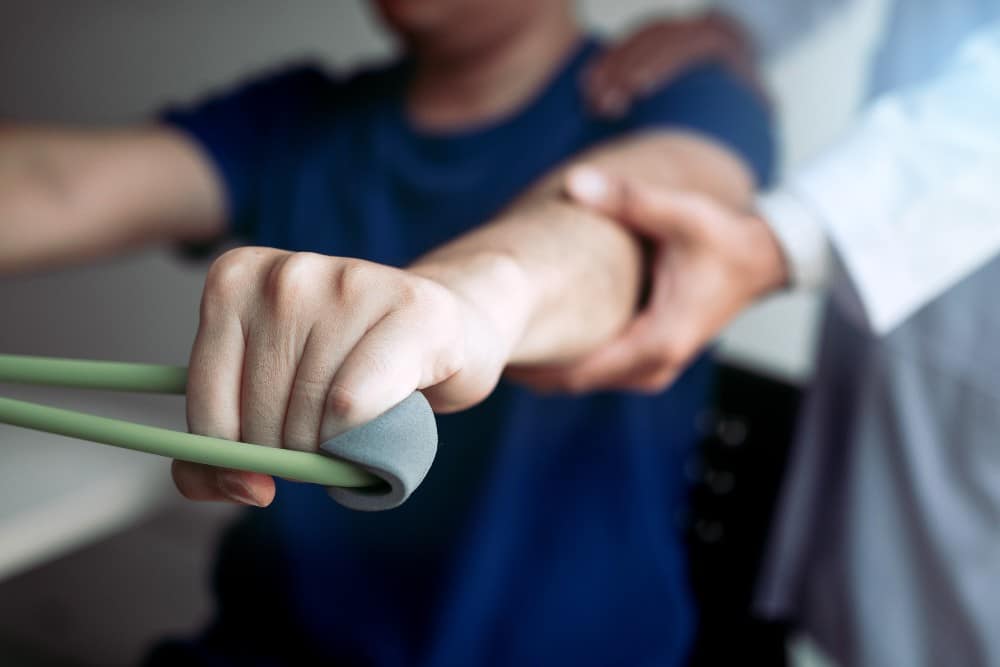Shoulder Bursitis
Have you ever had shoulder pain that made it difficult to move your arm? If so, you may have had shoulder bursitis. This condition is a common cause of shoulder pain, and it can occur in people of all ages. So, what is shoulder bursitis? How does it occur? What are the symptoms? And how is it treated?
Let’s start with the basics.
What is Shoulder Bursitis?
Shoulder bursitis is a condition that occurs when the bursa, a small fluid-filled sac, becomes inflamed. The bursa is located near the shoulder joint and helps to cushion and lubricate the joint. When the bursa becomes inflamed, it can cause pain and stiffness in the shoulder.
When you use your shoulder, the bursa helps to reduce friction between the bones, tendons, and muscles in the joint. However, when the bursa becomes inflamed, this friction-reducing effect is reduced, and you may feel pain when you move your shoulder.
What are the Symptoms of Shoulder Bursitis?
The symptoms of shoulder bursitis can vary depending on the severity of the inflammation. However, the most common symptoms include:
- Pain in the shoulder, especially when moving the arm.
- Stiffness in the shoulder.
- Swelling in the shoulder.
- Redness or warmth in the shoulder.
If the inflammation is severe, you may also experience fever, chills, and fatigue.
What Causes Shoulder Bursitis?
There are several things that can cause the bursa to become inflamed, including:
- Repeated overhead motions of the arm, such as those often used in tennis or swimming.
- A fall or direct blow to the shoulder.
- Pressure on the shoulder, such as from leaning on it.
- Degenerative changes in the shoulder joint.
- Infection, bacteria, or viruses.
Shoulder bursitis is also more common in people with certain medical conditions, such as rheumatoid arthritis, gout, and diabetes.
Understanding Shoulder Bursitis
Internally, the shoulder joint is a ball-and-socket joint. The ball is the head of the humerus (upper arm bone) and the socket is the glenoid, a shallow cavity in the shoulder blade. The bursa is located between the head of the humerus and the glenoid.
There are two types of shoulder bursitis:
Subacromial bursitis: This type of bursitis occurs when the bursa becomes inflamed due to repeated overhead motions of the arm or direct pressure on the shoulder. It is the most common type of shoulder bursitis.
Subdeltoid bursitis: This type of bursitis occurs when the bursa becomes inflamed due to a fall or direct blow to the shoulder. It is less common than subacromial bursitis.
Treatments for Shoulder Bursitis
There are several treatments for shoulder bursitis, and the best treatment for you will depend on the severity of your symptoms.
Rest: One of the best things you can do for shoulder bursitis is to rest your shoulder. Avoid activities that require you to use your shoulder, such as overhead activities or activities that involve reaching behind your back.
Ice: Applying ice to the affected shoulder can help to reduce pain and inflammation. Try to ice your shoulder for 20-30 minutes at a time, several times a day.
Physical therapy: Physical therapy can help to improve range of motion and reduce pain. Your physical therapist will design a specific exercise program for you based on your individual needs. When done correctly, exercises can help to reduce the risk of shoulder bursitis recurring. Do not attempt physical therapy on your own without the guidance of a trained professional, as you may end up doing more harm than good.
NSAIDs: Nonsteroidal anti-inflammatory drugs (NSAIDs) can be effective in treating pain and inflammation associated with shoulder bursitis. Common NSAIDs include ibuprofen (Advil) and naproxen (Aleve). Be sure to follow the instructions on the label when taking these medications.
Shoulder splint or sling: Wearing a splint or sling can help to immobilize your shoulder and give it a chance to rest. This can be especially helpful for people who have a hard time resting their shoulder on their own, or for people who have severe pain.
Corticosteroids: In some cases, a doctor may recommend a corticosteroid injection to help reduce pain and inflammation. These injections are typically only done if other treatments have failed to provide relief. The corticosteroid is injected into the bursa, and the effects can last for several months. It works by reducing inflammation, but there is a risk of bursitis recurring once the corticosteroid wears off.
Bursa (steroid) injections: Other than corticosteroids, another medication that can be injected into the bursa is a local anesthetic. This will help to provide pain relief, but will not reduce inflammation.
Antibiotics: If an infection causes your bursitis, you will need to take antibiotics. The type of antibiotic will depend on the bacteria causing the infection. The infection will need to be treated before your bursitis can be resolved.
For more extreme cases – surgery: If the above treatments do not improve your symptoms, or if your bursitis is caused by an infection, you may need surgery. Surgery is typically a last resort but can be effective in treating shoulder bursitis. The type of surgery will depend on the cause of the shoulder bursitis but may involve removing the bursa, cleaning out the infection, or repairing any damage to the shoulder.
Stretches and Exercises for Building Strength
Pectoralis Minor Stretch
Start by standing in an open door frame with your elbows at shoulder level and your forearms parallel to the ground. Lean forward until you feel a stretch in your chest. Hold for 30 seconds and repeat 3 times.
Door Frame Chest Stretch
Start by standing in an open door frame with your elbows at shoulder level and your forearms parallel to the ground. Lean forward until you feel a stretch in your chest. Hold for 30 seconds and repeat 3 times.
Seated Row
Sit with your legs straight and lean back slightly, keeping your back straight. Grasp the handles of a resistance band or dumbbells with your palms facing your body. Pull the handles back, leading with your elbows, until your hands are at your sides. Return to the starting position and repeat 10 times.
External Rotation
Sit with your arms at your sides and a lightweight in your hand. Rotate your arm so that your palm is facing away from your body. Return to the starting position and repeat 10 times.
Lateral Raise
Start by standing with your feet shoulder-width apart and a weight in each hand. Raise your arms out to the sides until they are parallel to the ground. Return to the starting position and repeat 10 times.
You should not feel pain with any of these exercises. If you do, stop and consult your doctor or physical therapist.
Contact Us Today for Help
If you’re suffering from shoulder bursitis, the team at Premier Podiatry & Orthopedics can help. We offer a full range of orthopedic services that can help to treat your condition and get you back to your normal activities. Contact us today to schedule an appointment.
Looking to schedule an appointment with a physician?
Carmichael Office
6620 Coyle Avenue,
Suite 202
Carmichael, CA 95608
Roseville Office
576 N Sunrise Avenue,
Suite 230
Roseville, CA 95661
Folsom Office
1580 Creekside Drive,
Suite 100 & 110
Folsom, CA 95630
Social
© Premier Podiatry & Orthopedics. All Rights Reserved. | Privacy Policy


